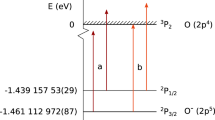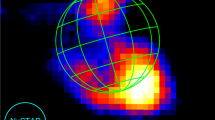Abstract
THE green auroral line of oxygen at 5,577 A. (1D2 – 1D0) has been found by Vegard and Kvifte1, and Jenkins, Bowtell and Strong2 in the afterglow of a Tesla discharge through argon, or a mixture of argon and nitrogen, at nearly atmospheric pressure, when there is a minute trace of oxygen present. It is accompanied by a diffuse band similar to one described by L. and R. Herman3. We have made some measurements of the decay of this phosphorescence, which can be followed by a photo-multiplier connected through an amplifier to a cathode ray oscillograph with a low-frequency time base. Three sources have been used, namely, two 300-watt commercial Osram gas-filled lamps, and a cylindrical tube 21 cm. long and 6 cm. in diameter containing a similar gas mixture, with two rod electrodes 2 mm. in diameter, mounted near one end with their tips 3 cm. apart. The photomultiplier was exposed to the glow from a volume of gas about 3 cm. in linear dimensions.
This is a preview of subscription content, access via your institution
Access options
Subscribe to this journal
Receive 51 print issues and online access
$199.00 per year
only $3.90 per issue
Buy this article
- Purchase on Springer Link
- Instant access to full article PDF
Prices may be subject to local taxes which are calculated during checkout
Similar content being viewed by others
References
Vegard, L., Kvifte, G., Nature, 162, 967 (1948).
Jenkins, H. G., Bowtell, J. N., and Strong, R. W., Nature, 163, 401 (1949).
Herman, L., and R., Ann. Géophys., 1, 165 (1944).
Pasternack, Astrophys. J., 92, 129 (1940).
Janin, J., Thesis, Paris (1946).
Jeans, J. H., “Kinetic Theory of Gases”, Chapter 7 (Cambridge, 1940).
Author information
Authors and Affiliations
Rights and permissions
About this article
Cite this article
EMELÉUS, K., SAYERS, N. & BAILEY, R. Possibility of Measuring a Quadrupole Transition Probability from an Auroral Afterglow. Nature 166, 656–657 (1950). https://doi.org/10.1038/166656a0
Issue Date:
DOI: https://doi.org/10.1038/166656a0
This article is cited by
-
Laboratory Production of the Vegard – Kaplan Bands
Nature (1955)
Comments
By submitting a comment you agree to abide by our Terms and Community Guidelines. If you find something abusive or that does not comply with our terms or guidelines please flag it as inappropriate.



